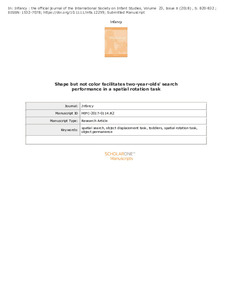| dc.date.accessioned | 2021-10-25T13:41:44Z | |
| dc.date.available | 2021-10-25T13:41:44Z | |
| dc.date.issued | 2018 | |
| dc.identifier | doi:10.17170/kobra-202108234629 | |
| dc.identifier.uri | http://hdl.handle.net/123456789/13322 | |
| dc.description | We thank Alexander Reschke for recruiting the participants and collecting the data and all parents and their children for their participation in this study.
This study was conducted in line with the ethical standards of the American Psychological Association (APA) and the German Association of Psychology (DGPs), which are in accordance with guidelines laid down in the Declaration of Helsinki, with written informed consent obtained from a parent or guardian for each child before any assessment or data collection. The University of Kassel, where the study was conducted, demands no further, obligatory ethics statement.
This is the submitted manuscript version of the following article: Mirjam Ebersbach and Christian Nawroth: Shape But Not Color Facilitates Two-Year-Olds’ Search Performance in a Spatial Rotation Task (2018), which has been published in final form at https://doi.org/10.1111/infa.12259. This article may be used for non-commercial purposes in accordance with Wiley Terms and Conditions for Use of Self-Archived Versions | ger |
| dc.language.iso | eng | eng |
| dc.rights | Urheberrechtlich geschützt | |
| dc.rights.uri | https://rightsstatements.org/page/InC/1.0/ | |
| dc.subject | spatial search | eng |
| dc.subject | object displacement task | eng |
| dc.subject | toddlers | eng |
| dc.subject | spatial rotation task, | eng |
| dc.subject | object permanence | eng |
| dc.subject.ddc | 150 | |
| dc.title | Shape But Not Color Facilitates Two-Year-Olds’ Search Performance in a Spatial Rotation Task | eng |
| dc.type | Aufsatz | |
| dcterms.abstract | Children younger than 3 years of age often fail to track hidden objects that are rotated together with identical hiding containers, which might be due to relatively complex paradigms. We examined whether 2-year-olds (N = 28) are already able to track spatial rotations (i.e., by 90° and 180°) if the task is facilitated by increasing the visual discriminability of the hiding containers by means of different shapes and different colors. Children performed above chance level in all conditions except for the condition in which containers had the same color and shape and were rotated by 180°. Moreover, children found the hidden object more often when the containers had different—as compared to identical—shapes, whereas performance was similar when the containers had the same or different colors. Furthermore, their performance was better after 90° rotations than after 180° rotations and children in all conditions showed an inhibition bias. Our findings suggest that 2-year-olds are already able to track spatial rotations if the task is kept simple and focuses solely on the ability of interest. In addition, young children use shape—rather than color—as a salient dimension in spatial rotation tasks. | eng |
| dcterms.accessRights | open access | |
| dcterms.creator | Ebersbach, Mirjam | |
| dcterms.creator | Nawroth, Christian | |
| dc.relation.doi | doi:10.1111/infa.12259 | |
| dc.subject.swd | Drehung | ger |
| dc.subject.swd | Raumvorstellung | ger |
| dc.subject.swd | Kognitive Entwicklung | ger |
| dc.subject.swd | Kleinkind | ger |
| dc.type.version | submittedVersion | |
| dcterms.source.identifier | eissn:1532-7078 | |
| dcterms.source.identifier | issn:1525-0008 | |
| dcterms.source.issue | Issue 6 | |
| dcterms.source.journal | Infancy : the official journal of the International Society on Infant Studies | eng |
| dcterms.source.pageinfo | 820-832 | |
| dcterms.source.volume | Volume 23 | |
| kup.iskup | false | |

